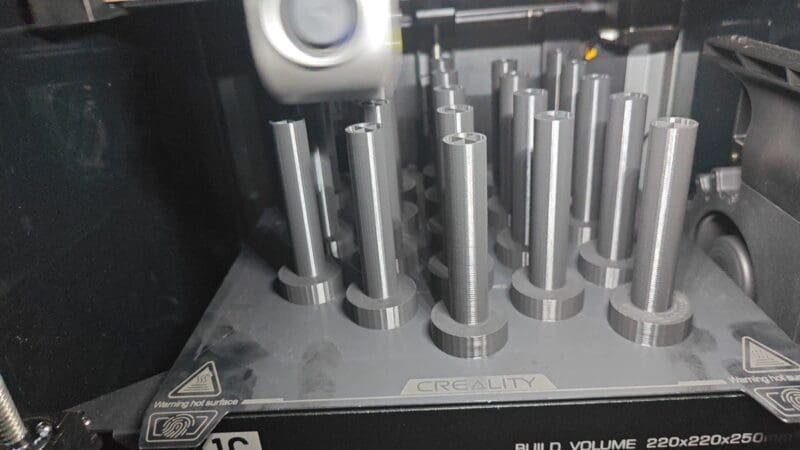What is the Best Way to Dry Filament? 4 Answers You Should Know

When it comes to drying filament, there are several methods you can use to ensure that your 3D prints turn out high-quality. Whether you have a dedicated filament dryer or need to use household appliances, there is a solution that will work for you.
Here are four effective methods for drying filament:
Method 1: Using a Filament Dryer
Filament dryers are designed specifically for curing filaments and offer a user-friendly solution to ensure that your filament is dried effectively and efficiently.
Read > Best Filament Dryer in 2024: Top 5 in the Market
How do I use a filament dryer?
To use a filament dryer, start by cutting your filament into small sections to ensure that they can fit comfortably inside the dryer.
Next, lay baking paper or tin foil on the tray of the dryer to prevent the filament from sticking. Place the filaments evenly on the tray and set the temperature to a suitable range for your filament material.
The drying time will depend on the length of the filament and the temperature of the dryer, so be sure to monitor the process closely.
Once the filament has been dried, it’s important to let it cool down in a ventilated place before using it. This will ensure that the filament returns to its proper consistency and is ready for high-quality 3D printing.
Factors to consider when choosing a filament dryer?
When choosing a filament dryer, there are a few factors to consider.
First, make sure that the dryer has sufficient capacity to hold your filament spools.
Additionally, check that the dryer offers the appropriate temperature range for your specific filament materials. It’s also helpful to look for practical functions such as automatic power-off and over-temperature protection for added safety and convenience.
Finally, consider the price of the filament dryer and choose one that fits within your budget.
Method 2: Oven Drying
Another one of the most accessible methods is using your trusty oven. That’s right, the same appliance you use to bake delicious treats can also be used to dry out your filament. Oven drying is a cost-effective solution that can be done in the comfort of your own home.
To get started, preheat your oven to a low temperature. The exact temperature will depend on the type of filament you are using, so be sure to check the recommended drying temperature for your specific material. For example, PLA filament typically requires a drying temperature of 40°C-50°C, while ABS filament may need a slightly higher temperature of around 80°C-90°C.
Read > Best Cheap PLA Filament Brands for Your 3D Printing Needs
Before placing your filament in the oven, it’s important to protect it from sticking to the baking tray. You can do this by lining the tray with baking paper or tin foil. This will ensure that your filament remains in good condition while it is being dried.
Next, place them on the lined baking tray. Make sure to spread them out evenly to ensure thorough drying.
Once your oven has reached the desired temperature, place the baking tray with the filament inside. Let it dry for 2-4 hours, depending on the length of the filament and the recommended drying time for your specific material.
While the filament is drying, keep a close eye on the oven temperature to prevent overheating. If the temperature exceeds the recommended drying temperature, it can cause the filament to melt or become deformed.
After the drying time has elapsed, carefully remove the baking tray from the oven and allow the filament to cool naturally.
It’s worth noting that oven drying is a popular method among 3D printing enthusiasts, but it does require some caution. Always ensure that your oven has an accurate thermostat to prevent overheating, and never leave the filament unattended while it is drying.
Method 3: Food Dehydrator

If you’re looking for a cost-effective and efficient way to dry your filament, a food dehydrator might be the perfect solution for you. Food dehydrators are designed to remove excess moisture from food items, but they can also be repurposed to dry filament effectively.
How to Use a Food Dehydrator for Filament Drying
Using a food dehydrator to dry your filament is a straightforward process. Here’s a step-by-step guide to help you get started:
Prepare the Filament: Cut your 3D printer filament into small sections to ensure even drying.
Set the Temperature: Adjust the temperature of your food dehydrator to the recommended drying temperature for your filament material.
Line the Tray: Place a sheet of baking paper or tin foil on the tray of the food dehydrator to prevent the filament from sticking to the surface.
Arrange the Filament: Lay the filament sections evenly on the lined tray, ensuring that they are not touching each other. This allows for proper airflow and even drying.
Start the Drying Process: Place the tray with the filament inside the food dehydrator and set the timer according to the recommended drying time for your filament material.
Check the Filament: After the initial drying period, take out the tray and inspect the filament for any signs of moisture. If it still feels damp or shows any signs of moisture, continue the drying process for an additional hour or two.
Cool the Filament: Once the filament is completely dry, remove the tray from the food dehydrator and allow the filament to cool naturally in a well-ventilated area. Avoid placing the hot filament directly into a closed container, as it may trap residual moisture.

Additional Tips for Using a Food Dehydrator
To ensure the best results when using a food dehydrator for filament drying, here are a few additional tips:
Monitor the Temperature: Keep a close eye on the temperature inside the food dehydrator to avoid overheating or melting the filament. Use an external thermometer to verify the accuracy of the dehydrator’s temperature settings.
Rotate the Trays: If your food dehydrator has multiple trays, consider rotating them during the drying process. This helps to ensure even drying and prevents any sections of the filament from being overlooked.
Store Filament Properly: After drying your filament, store it in a dry and airtight container to prevent moisture absorption. You can also use moisture-absorbing packets, such as silica gel, to further protect your filament from humidity.
Method 4: Proper Storage
Proper storage of filament is essential to maintain its quality and prevent moisture absorption. Even if you have successfully dried your filament, it is important to store it correctly to avoid reabsorption of moisture and maintain its optimal properties. Here are some tips for proper filament storage:
Choose a dry and controlled environment: Store your filament in a dry and controlled environment to minimize exposure to moisture. Avoid storing it in areas with high humidity, such as basements or bathrooms. Ideally, the humidity level should be below 50% to prevent moisture absorption.
Use airtight containers or bags: Place your filament spools in airtight containers or bags to protect them from moisture in the air. You can use sealable plastic bags or specialized filament storage containers. Make sure to remove as much air as possible before sealing the bags or containers to create a moisture-free environment.
Add moisture-absorbent materials: To further protect your filament from moisture, consider adding moisture-absorbent materials such as silica gel packets or desiccant packs to the storage containers or bags. These materials help to absorb any moisture that may be present, keeping your filament dry and in optimal condition.
Avoid direct sunlight and heat sources: Keep your filament away from direct sunlight and heat sources, as exposure to high temperatures can cause the filament to deform or degrade. Store it in a cool and shaded area to maintain its integrity.
Regularly check the filament: Periodically check your filament for any signs of moisture or damage. Look for changes in color, texture, or smell, as these can indicate moisture absorption. If you notice any signs of moisture, consider re-drying the filament before using it for printing.
Why Drying Filament is Important
Keeping your 3D printing filament bone-dry is a secret ingredient to nailing those perfect prints.
So, how do you keep your filament in tip-top shape?
You’ve got options, from specialized filament dryers to repurposing a food dehydrator or even giving it a spa day in a low-temp oven. The key is picking a method that fits your setup and keeps the heat gentle enough to drive out moisture without warping your filament.
But don’t stop at drying; storing your filament the right way is just as crucial. Think dry, sealed, and shielded from the humidity of the outside world. Toss in a desiccant pack for good measure, and you’ve got yourself a fortress against moisture.
Conclusion
In conclusion, ensuring that your filament is properly dried before starting a 3D printing project is crucial for achieving high-quality prints. Moisture in filament can lead to a range of issues that can affect the overall print quality and structural integrity of the final object. By using the appropriate drying methods and proper storage techniques, you can prevent these issues and achieve better results in your 3D prints.
DISCLOSURE: THIS POST MAY CONTAIN AFFILIATE LINKS, MEANING I GET A COMMISSION IF you DECIDE TO MAKE A PURCHASE THROUGH MY LINKS, AT NO COST TO YOU. PLEASE READ MY DISCLOSURE FOR MORE INFO.




![What is the Best Way to Dry Filament? 4 Answers You Should Know 9 Dry & Dry 20 Gram [10 Packets] Silica Gel Packets Desiccants, Silica Packets - Rechargeable Silica Gel Packs, Silica Gel Packets, Desiccants Packets, Silica Gel](https://m.media-amazon.com/images/I/5146ibxhOoL._SL160_.jpg)


